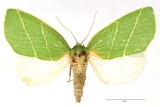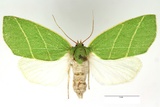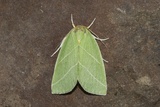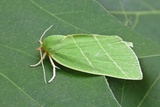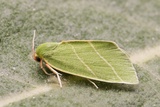Bena bicolorana (Fuessly, 1775) Species
Last modified: Nov. 12, 2025, 8:27 p.m.
A fairly common species throughout Belgium, more observed in the northern part of the country.
This species is considered Least Concern according to the IUCN Red List category for Flanders 2023.
Details
- Classification
- Family: Nolidae > Subfamily: Chloephorinae > Tribus: Chloephorini > Genus: Bena > Species: Bena bicolorana
- Vernacular names
- Grote groenuil (NL), Scarce Silver-lines (EN), La Halias du Chêne (FR), Großer Kahnspinner, Eichen-Kahnspinner (DE)
- Synonyms
- Bena quercana (Denis & Schiffermüller, 1775)
- First mention in Belgium
- De Sélys-Longchamps E. 1844. Énumération des insectes Lépidoptères de la Belgique. — Mémoires de la Société royale des Sciences de Liége 2: 1–35. On page 20 (as Halias quercana Wv.). view page
- Status
-
Native
Distribution
Bionomics
Hibernates as a small larva on or near a bud of the food plant.
Pupates in a tough, boat-shaped cocoon on the underside of a leaf of the food plant.
The adults come to light and sugar.
No pictures yet!
Flight periods
The adults fly from late May towards early August in one generation. In favourable years a small partial second generation occurs during September, but it's seldom recorded.
Observed on
- Host plant (genera):
- Quercus
- Substrates:
- Deciduous trees
The larva lives on Quercus or Betula.
No pictures yet!
